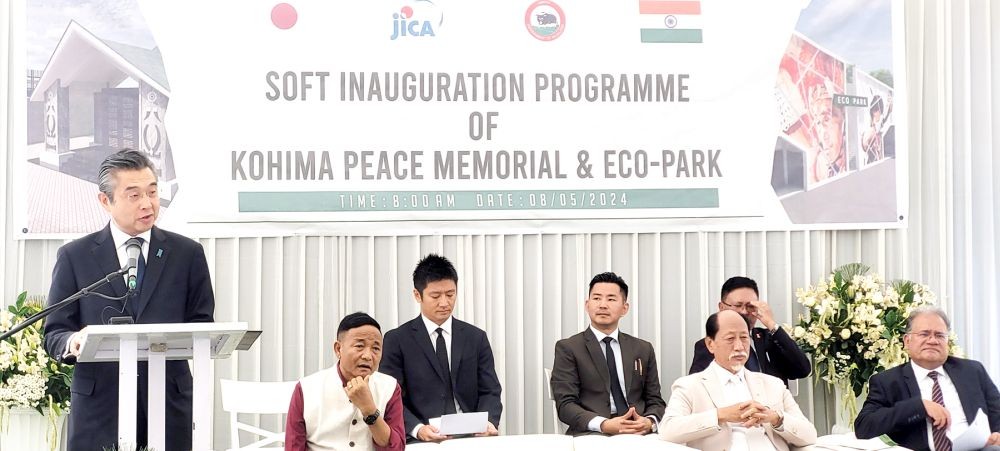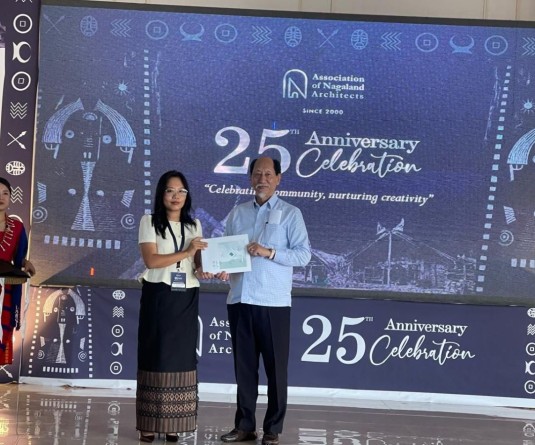Suzuki Hiroshi addressing the Soft inauguration programme of Kohima Peace Memorial & Eco- Park in Kohima on May 8. (Morung Photo)

Ambassador Hiroshi inaugurates Kohima Peace Memorial
Our Correspondent
Kohima | May 8
Suzuki Hiroshi, Ambassador of Japan to India today inaugurated the Kohima Peace Memorial (KPM) and laid the foundation stone for Eco-Park, located opposite to Capital Cultural Hall, Kohima, in the presence of Nagaland’s Chief Minister Neiphiu Rio.
Addressing inaugural, he said that the KPM and Eco-Park are going to be developed as part of Nagaland Forest Management project with ODA (Official Development Assistance) from the Japanese government.
“When completed, I can imagine that many people in Nagaland will visit the Eco-Park to have a relaxing stroll with their families and friends and enjoy the nature,” he said.
The Ambassador also expressed optimism that the park would become a new landmark in Kohima, symbolising the friendship between Japan and Nagaland.
Seizing skill opportunity in Japan
“We are also witnessing another chapter of friendship being fostered, with many young people from Nagaland starting to travel to Japan for skill training and job opportunities,” he said, adding that the Naga youths are getting good reputation in Japan and the Japanese host companies are keen to welcome more of them.
Hiroshi also recalled that in December last year, Japanese sending an organisation called ARMS signed MoU (Memorandum of understanding) with Nagaland University to establish a Japanese language course in Kohima.
“This, I hope, will encourage more and more Naga youths to learn Japanese language and seize skill training and job opportunities in Japan,” he said.
Appreciating CM Rio and all the people of Nagaland for the Peace Memorial, he said, “This Memorial, I hope, will invite more Japanese people to visit Kohima in the future.”
I am convinced that the friendship originally fostered through the remains collection between Japan and Nagaland will be further strengthened through the construction of Eco-Park as well as the exchange of young people, and they will become new bridges between India and Japan, Hiroshi added.
Offers condolences and acknowledges Nagaland’s role
Meanwhile, Hiroshi shared that the Battle of Kohima, along with “Battle of Imphal,” is remembered as one of the most disastrous battles in World War II by the Japanese people.
The monument of KPM “enable us to stand here in solemn silence, and offer our most sincere prayers to all the victims of the Battle,” he said.
He further noted that the people of Nagaland, who had nothing to do with the war, inevitably had to go through a great ordeal, with many being coerced into cooperation; losing their lives or suffering injuries, as well as being were forced to flee from the land of their ancestors.
Accordingly, he offered deepest sympathy and heartfelt condolences to the people of Nagaland who had to endure indescribable sufferings brought forth by the Battle of Kohima.
The Ambassador also highlighted that Japanese forces led by Lieutenant General Koutoku Sato, eventually, decided to retreat on account of lack of replenishments adding, “On their way back, countless soldiers lost their lives in the torrential monsoon rains due to lack of food and fatal diseases.”
Hence, he also prayed to the soul of all people - the people of Nagaland, the Japanese soldiers, the Indian National Army soldiers who took part in the campaign and those who fought on the British Commonwealth side.
“In August 1945, Japan surrendered and the Second World War came to an end. It was not until the mid- 1970’s, after the turmoil of the post-war reconstruction was over, that the former soldiers and their families visited Kohima to initiate a survey in order to collect the remains,” he said.
He said that the people of Nagaland, despite traumatic sufferings from the Battle of Kohima, welcome the visitors warmly, as old friends; and provided them with all possible support, he said.
Hiroshi said that Ajanuo Belho is the one of those who looked after them in the Kohima village at that time, and is still a volunteer with Kohima-Japan Bone Collection team.
“They are making great efforts to help the Japanese government in collecting the remains of the soldiers. I am deeply grateful to the people of Nagaland for their magnanimous generosity extended to the Japanese people,” he said.
Hiroshi maintained that the generosity has fostered a new friendship between Japan and Nagaland. Donations were raised from Japanese veterans of the Battle of Kohima and their families to help build the Kohima Cathedral.
Hiroshi joined ceremonial tree plantation at Eco-Park and laying of wreaths at KPM.
Later, he visited the Kohima War Cemetery, Kohima Cathedral, World War II Museum at Naga Heritage Village, Kisama and LIDI Krou Society, Kohima village.
In a short discussion with the Kohima village elders and members, Hiroshi acknowledged the Angamis for their hospitality and the bond of friendship till now, since the 2nd World war.




